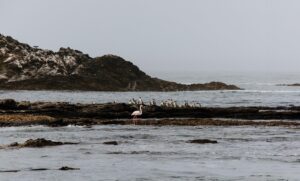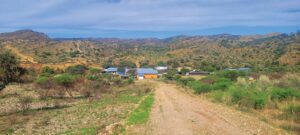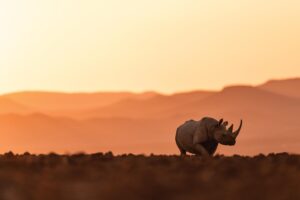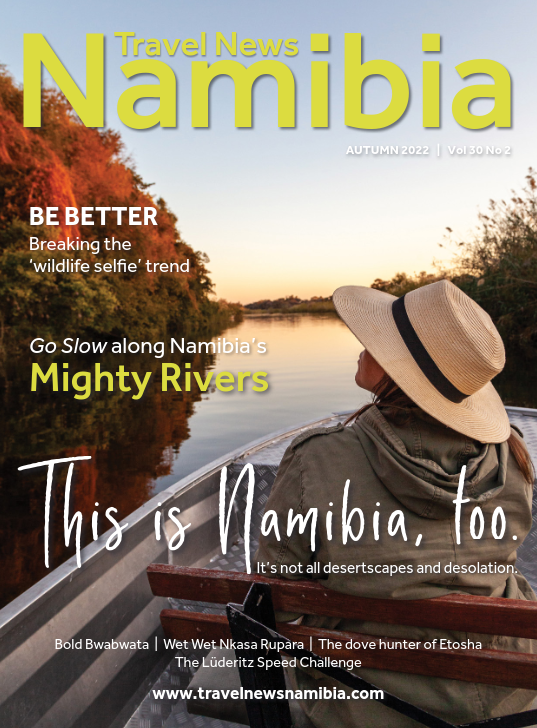
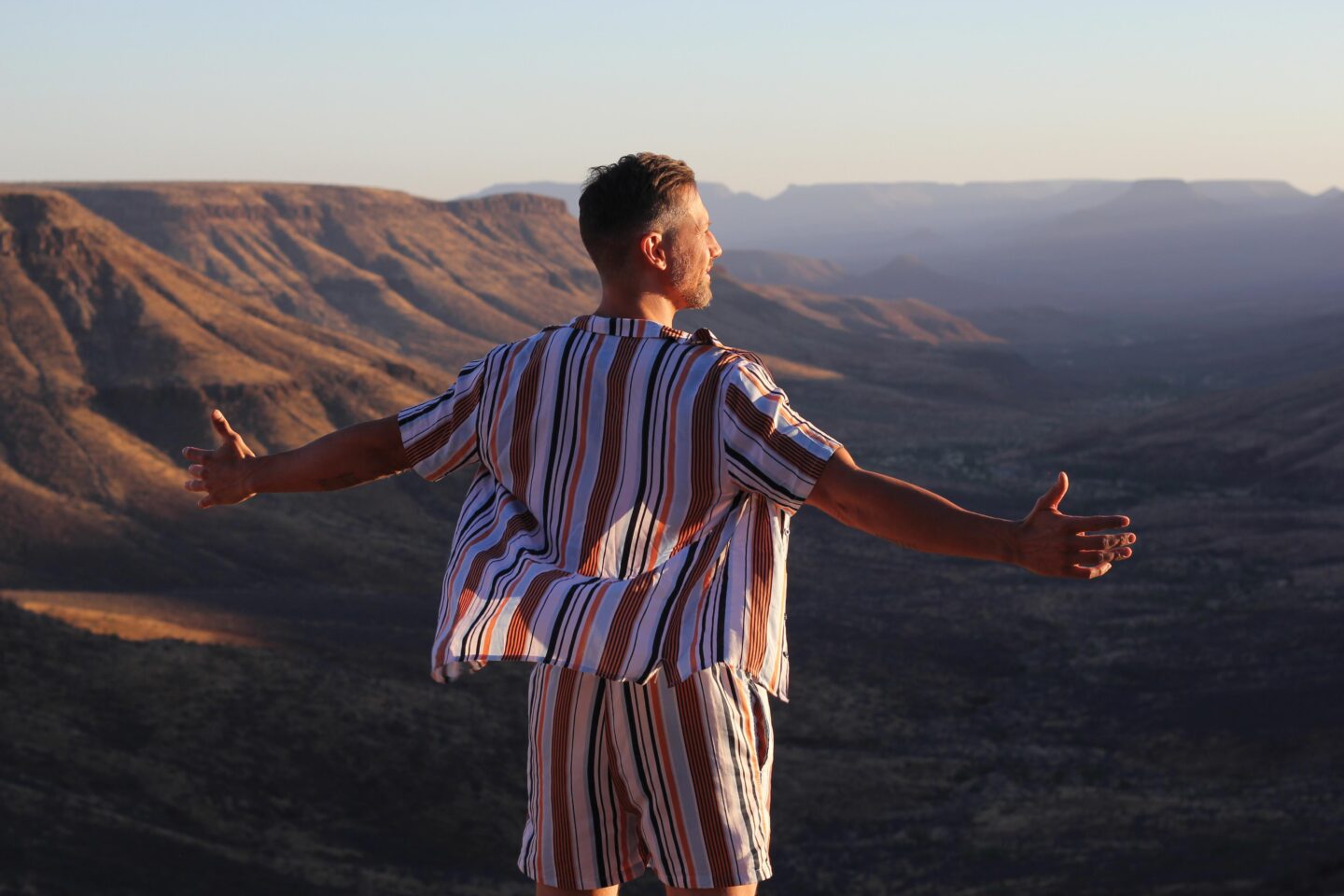
When conservation
becomes
a way of life
All of us had to adjust while the pandemic filtered into our day- to-day life, making major lifestyle changes as we went along. For nearly two years of having to find new creative ideas and hoping for the travel industry to recover, conservation continued… education continued… and so did the passion for sustainable tourism. You see, while the world seemingly came to a standstill, nature forced us to keep going. Conservation had to continue. Supporting communities had to continue. Therefore, tourism had to continue. Because conservancies and communities still rely on tourism.
Text Katja Haase | Photographs Victoria Paige & Brent Lindeque
From the Autumn 2022 issue
W ith this in mind, Journeys Namibia invited a group of wonderful influential guests from neighbouring South Africa. The group included journalists who highlighted the importance of sustainable tourism in our country, emphasising the importance of community lodges and conservation in Namibia, and essentially for Namibia. We focused on three of our lodges – those with a strong focus on community and conservation. Unique in their own way, each caters to different target markets and visitors. The goal should be to spread the word of conservancy lodges to different markets and to tell the story of the different fundamentals and projects that allow for change and opportunities in these communities. Maria Cantwell once said: “Conservation must be more than a convenient slogan.” We agree, conservation should not be convenient, but a lifelong passion and long-term preservation of nature passed on to future generations. We at Journeys Namibia strive for this every day.
“The standout image I have of my visit to Namibia is a feeling: a sublime and potentially contradictory combination of elation and extreme calm”
While this project was in the pipeline for some months, due to the pandemic and the travel restrictions that came with it, we celebrated the arrival of the group in Windhoek in November. And what better way to do so than by partnering up with other Namibian companies to be able to showcase the Land of the Brave to our South African friends:
- Namibia Car Rental offered the wheels for the trip;
- FlyNamibia hosted our guests on their flights from Cape Town to Windhoek;
- Am Weinberg was the first stop for our group in Windhoek;
- Strand Hotel was the last stop in Swakopmund;
- The Tug Restaurant provided dinner; and
- Rennies Travel organised the PCR Tests in Namibia.
THE THREE LODGES
After the first stay and evening in Windhoek at the stunning Am Weinberg, the group hit the road and made their way up to Hobatere Lodge. The lodge is situated on the western side of Etosha National Park, approximately 550 km north of Windhoek, and the perfect way to showcase the vastness and size of our beautiful Namibia.
“The standout image I have of my visit to Namibia is a feeling: a sublime and potentially contradictory combination of elation and extreme calm. I think this comes from the rare sense of isolation in mind-blowingly beautiful and extreme landscapes. In some places, you can feel like you (and your little crew) are the only people in the world – even that time is standing still. I’ve been to Namibia a few times and had that feeling every time. It’s a feeling I don’t think I’ve experienced anywhere else.” – Elizabeth Sleith, Sunday Times
While Hobatere Lodge could be considered a mini Etosha with its 24-hour game viewing opportunity overlooking a waterhole, it is also 100% community owned by the ≠Khoadi-//Hôas Conservancy. In addition, Hobatere Lodge is home to the Hobatere Lion Pride, which together with the Ministry of Environment, Forestry and Tourism (MEFT) creates a safe haven for the lions.
Visiting Hobatere Lodge, the group took part in a night drive to experience this area under the evening sky. Focusing on the nocturnal animals, birdlife and insects, it was clear to see that all species have their own purpose in the ecosystem.
After a hearty bush breakfast at Hobatere Lodge, the group continued to Grootberg Lodge, which also forms part of the ≠Khoadi-//Hôas Conservancy. Grootberg Lodge is unique in every way, being perched on the rim of the Etendeka Plateau with endless views over the Klip River valley. As the first mid-market establishment in the country that is 100% owned by a conservancy, it is a landmark in the Namibian tourism industry.
“Grootberg Lodge – the layout, the beautiful rooms, that incredible infinity pool and the kind, attentive staff. It really is a little slice of heaven.” – Brent Lindeque, Good Things Guy
12 000 hectares have been set aside by the ≠Khoadi-//Hôas community for conservation and tourism. It is in this pristine wilderness that guests can explore either on foot or by car to encounter some of Namibia’s iconic wildlife species, including the desert-adapted elephant and black rhino. While the group visited the lodge, they were introduced to the community, got to spend the day searching for the elusive desert-adapted elephants and took part in very important chats with our guide, Bob, about human-wildlife conflict. Over the last seven years, droughts have tremendously affected the northwest of Namibia, the people of the area had to adapt and with that have encountered new challenges in order to survive. As have the animals in the area. Human- wildlife conflict is not a new term, yet it is one that moves to the forefront, especially in times like these, where tourism has fallen away in many parts of the country and farmers are dependent on their livestock or crops.
“Sustainable tourism, particularly in Africa, whose main selling point is the natural resources of wildlife and ‘untouched’ landscapes, is non-negotiable. The terms ‘sustainability’ and ‘responsible tourism’ have been gaining traction for a while now and it’s clear they will become even more important in a post-pandemic world. The best assets of Namibia are those parts that are completely natural and untouched and the preservation of these spaces is in part enabled and encouraged through the funding that tourism provides. This is the main appeal of the word ‘sustainable’ to me. Most notably, the value of involving communities is the persuading of the people who live on the land to protect these assets for the long term, rather than sell them out for short-term gains. I do think, however, that it is a term easily used and I have seen many instances of hotels and lodges overtly claiming ‘sustainability’ credentials while blatantly committing environmental/social crimes (not, however, in Namibia). I hope that in general more and more tourism providers will put their money where their mouth is and not simply use ‘sustainability’ as a buzzword with little actual action to back it up.” – Elizabeth Sleith, Sunday Times
“It is easy to get lost in the history of the Skeleton Coast and to be mesmerised by the stories of the shipwrecks found in the area, not to mention the unbelievably scenic landscape that is both unexpected and spectacular”
For many in the group, Shipwreck Lodge and the Skeleton Coast National Park was the highlight of the trip. Especially for Jonathan Boynton-Lee: “Visiting the Skeleton Coast has been on my bucket list for many years. In fact, for my final matric art project, I actually painted one of the shipwrecks from the Skeleton Coast. So, for more than 20 years I’ve wanted to visit the area.”
It is easy to get lost in the history of the Skeleton Coast and to be mesmerised by the stories of the shipwrecks found in the area, not to mention the unbelievably scenic landscape that is both unexpected and spectacular. And let’s not forget the quad bike activity that will get your blood pumping. The dry riverbed of the Hoarusib River is home to many different species of wildlife, some sand falls and clay castles, bringing to mind a long-lost mediaeval city.
“Perhaps it is linked to the community investment in the places we stayed, but the secret weapon for me was absolutely the human element. There are many slick destinations where the hospitality, while flawless, can feel mechanical and insincere. This is totally understandable (it’s a job), but I think the standout element of my experiences in Namibia is a genuine sense of ‘welcomeness’ and warmth from the hosts and communities. The underlying sense is that there is a genuine pride in the country and its assets, and an eagerness to share this with visitors, as well as a relaxed and friendly approach to life that South Africans share.” – Elizabeth Sleith, Sunday Times
Having the last sundowner on the dunes overlooking the lodge and seeing the waves of the Atlantic Ocean rushing in makes one realise that we as humans are such a small element of our ecosystem, and we too have our place on this planet. Sustainable tourism should not only be a buzzword; it should be the way forward.
Namibia has been a leading example of ecotourism, being dedicated and focused to the cause, giving purpose to our communities and creating living spaces where humans and wildlife can coexist in harmony. We are very happy to be able to share this need for conservation and love for our country with our visitors and hope that the past two years have paved the way to preserving our natural habitats. TNN


